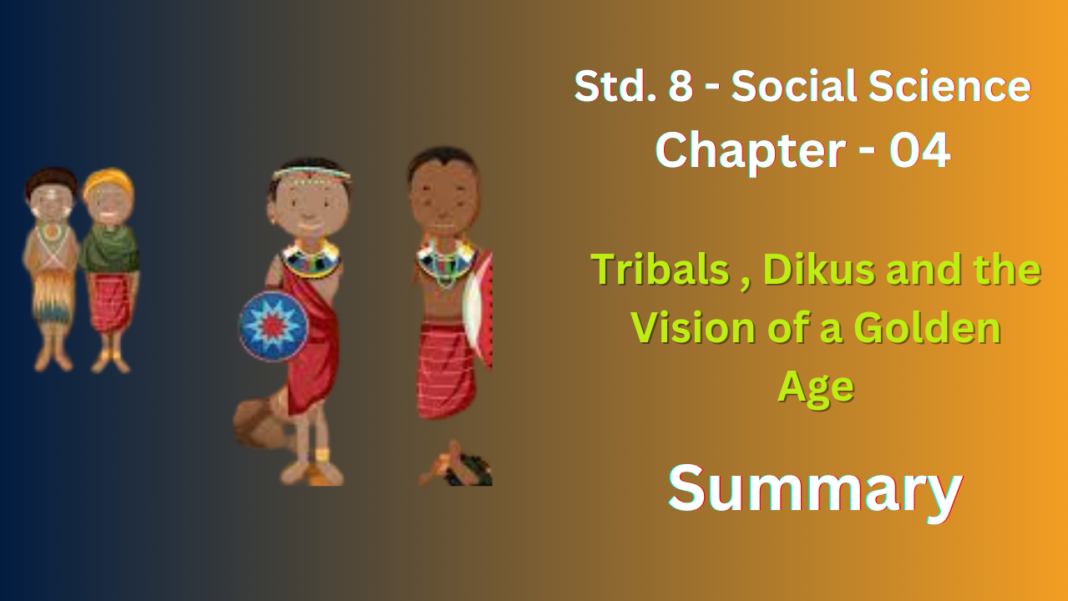NCERT Solutions for Class 8 History Chapter 4
The Tribals Dikus and the Vision of a Golden Age chapter explores the growing tensions between tribal communities and outsiders (“dikus”) during British rule in India. Here’s a quick breakdown:
- Land and Identity: Tribals traditionally viewed land as a shared resource, not a commodity. The British land policies and arrival of outsiders disrupted these traditions and threatened their way of life.
- Exploitation and Discontent: The introduction of moneylenders, traders, and landlords often led to exploitation of tribal communities, fueling resentment.
- Missionaries and Change: Christian missionaries, seen as representatives of the “dikus,” challenged tribal customs and beliefs, creating further friction.
- Birsa Munda’s Vision: The chapter focuses on Birsa Munda, a tribal leader who emerged in the late 19th century. He preached a return to a golden age (“Satyuga”) free from diku influence and social evils.
- Rebellion and Reforms: Birsa Munda’s movement combined religious revivalism with resistance against the British and diku dominance. His movement, though ultimately unsuccessful, highlighted tribal discontent.
In essence, the chapter explores the impact of British colonialism on tribal communities, their struggles to preserve their way of life, and the rise of resistance movements like Birsa Munda’s.
NCERT Solutions for Class 8 History Chapter 4
Exercise
1. Fill in the blanks:
- The British described the tribal people as …………
- The method of sowing seeds in jhum cultivation is known as …………….
- The tribal chiefs got …………. titles in central India under the British land settlements.
- Tribals went to work in the of Assam and the ……………… in Bihar.
Ans :
- The British described the tribal people as “aboriginals” or “primitive”.
- The method of sowing seeds in jhum cultivation is known as “dibbling”.
- The tribal chiefs got “malguzar” titles in central India under the British land settlements.
- Tribals went to work in the tea plantations of Assam and the coal mines in Bihar.
2. State whether true or false:
- Jhum cultivators plough the land and sow seeds.
- Cocoons were bought from the Santhals and sold by the traders at five times the purchase price.
- Birsa urged his followers to purify themselves, give up drinking liquor, and stop believing in witchcraft and sorcery.
- The British wanted to preserve the tribal way of life.
Ans :
- False
- True
- True
- False
3. What problems did shifting cultivators face under British rule?
Ans : Shifting cultivators under British rule faced a tough life:
- Land Grab: British land laws restricted their movement and access to fallow land needed for jhum cultivation.
- Forest Blues: Forest controls limited access to resources crucial for their way of life.
- Debt Traps: Cash crop pressure and exploitative outsiders led them into debt cycles.
- Forced Labor: Development projects displaced them, and some were forced into wage labor.
British rule squeezed their traditional lifestyle, leaving them vulnerable and worse off.
4. How did the powers of tribal chiefs change under colonial rule?
Ans : Under British rule, tribal chiefs lost power:
- From Leaders to Middlemen: Chiefs lost their administrative authority as the British established their own systems. They became intermediaries between the British and the tribes.
- Land Rights Blurred: Colonial land settlements messed with traditional ownership practices. Chiefs might have kept titles, but their control over land and resources weakened.
- Tax Collectors (Unpopular Ones): Sometimes forced to collect taxes for the British, they faced resentment from their own people.
- Direct Dealing: The British preferred dealing directly with tribal people, further sidelining the chiefs.
Overall, tribal chiefs went from powerful leaders to figures with limited influence under British rule.
5. What accounts for the anger of the tribals against the dikus?
Ans : Tribals resented “dikus” (outsiders) for:
- Land Grab: British policies and diku settlers squeezed tribals off their lands.
- Debt Traps: Diku traders and moneylenders exploited them with low prices and high-interest loans.
- Cultural Clash: Diku culture and missionaries challenged tribal traditions.
- Forced Removals: Development projects displaced tribals, and some faced forced labor.
- Loss of Power: British rule weakened tribal chiefs and squeezed tribal autonomy.
Overall, British colonialism and dikus disrupted the tribal way of life, leading to anger and resentment.
6. What was Birsa’s vision of a golden age? Why do you think such a vision appealed to the people of the region?
Ans : Birsa Munda, a tribal leader in the late 19th century, envisioned a golden age called “Satyuga.” Here’s what it entailed and why it resonated with the tribal people:
Birsa’s Golden Age (Satyuga):
- Free from Dikus: This golden age was free from the exploitation and oppression by the British (“dikus”) and diku landlords.
- Tribal Self-Sufficiency: Birsa envisioned a time where tribal communities were self-sufficient, living off their land and practicing traditional customs without outside interference.
- Equality and Justice: His vision emphasized a society based on equality and justice, free from the social evils and economic hardship brought about by British rule.
- Religious Revival: Birsa incorporated elements of both Hinduism and tribal religions, aiming for a spiritual renewal alongside social and political reforms.
Appeal to the Tribal People:
- Loss and Exploitation: Birsa’s vision resonated with the tribal people who were facing land loss, resource depletion, and economic exploitation under the British and diku dominance.
- Yearning for Autonomy: The dream of self-sufficiency and freedom from outside control appealed to their desire to retain their traditional way of life.
- Hope for a Better Future: Birsa’s vision offered hope for a future free from the hardships they were facing, restoring their dignity and cultural identity.
7. Find out from your parents, friends or teachers, the names of some heroes of other tribal revolts in the twentieth century. Write their story in your own words.
Ans :
- Alluri Sitarama Raju: Fought British control over forests in Andhra Pradesh, a symbol of tribal resistance.
- Rani Gaidinliu: Young leader from Manipur who defied British rule using non-violent methods alongside her mentor.
8. Choose any tribal group Hiring in India today. Find out about their customs and way of life, and how their lives have changed in the last 50 years.
Ans :
- Alluri Sitarama Raju: Fought British control over forests in Andhra Pradesh, a symbol of tribal resistance.
- Rani Gaidinliu: Young leader from Manipur who defied British rule using non-violent methods alongside her mentor.
NCERT Solutions for Class 8 History Chapter 4
FAQ’s
What is the main theme of NCERT Solutions for Class 8 History Chapter 4?
The main theme of NCERT Solutions for Class 8 History Chapter 4 is the impact of colonial rule on tribal societies, their interactions with outsiders (Dikus), and their vision of an ideal world.
Who are the ‘Dikus’ mentioned in NCERT Solutions for Class 8 History Chapter 4?
‘Dikus’ refer to outsiders such as moneylenders, traders, and British officials who exploited and disrupted the traditional tribal way of life, as detailed in “Tribals, Dikus, and the Vision of a Golden Age.”
What was the impact of British colonial policies on tribal communities according to NCERT Solutions for Class 8 History Chapter 4?
British colonial policies led to the loss of tribal lands, imposition of new taxes, and forced labor, significantly affecting tribal autonomy and livelihoods, as discussed in “Tribals Dikus and the Vision of a Golden Age.”
How did tribals resist the British and Dikus as per NCERT Solutions for Class 8 History Chapter 4?
Tribals resisted through uprisings, forming alliances, and reviving traditional practices. Significant rebellions like the Santhal Rebellion are highlighted in “Tribals Dikus and the Vision of a Golden Age.”
What role did religion and culture play in tribal resistance according to NCERT Solutions for Class 8 History Chapter 4?
Religion and culture played a crucial role in uniting tribes and inspiring resistance movements, as many tribal leaders invoked religious sentiments to rally support against colonial oppression, as explained in “Tribals, Dikus, and the Vision of a Golden Age.”
What was the Vision of a Golden Age for the tribals as mentioned in NCERT Solutions for Class 8 History Chapter 4?
The Vision of a Golden Age for tribals was an idealized past where they lived in harmony with nature, free from exploitation and oppression by outsiders, as detailed in “Tribals Dikus and the Vision of a Golden Age.”









